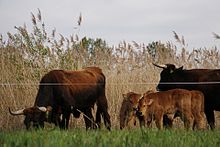Hässeler Weiher von Neuenhaßlau
| Hässeler Weiher von Neuenhaßlau | ||
|---|---|---|

|
||
| Information board at the NSG | ||
| Geographical location |
Germany ( Hessen , Main-Kinzig-Kreis ) Between. Langenselbold and Gründau |
|
| Drain | Hasselbach | |
| Data | ||
| Coordinates | 50 ° 10 '29 " N , 9 ° 5' 35" E | |
|
|
||
| Altitude above sea level | 121 m | |
| surface | 14ha | |
|
particularities |
Is under nature protection. |
|
Hässeler Weiher von Neuenhaßlau is the name of a nature reserve in the Main-Kinzig district between Langenselbold and Gründau , Hesse.
The nature reserve Hässeler Weiher von Neuenhaßlau with a size of about 14 hectares was placed under protection by ordinance of 23 November 1976. It covers an area of Neuenhaßlau between the Kinzig and the Frankfurt – Bebra railway line .
Concept of year-round multi-species grazing
After a failed attempt at tending to water buffalo in 2012/2013, a concept of year-round multi-species grazing was implemented in 2016. The nature reserve is now grazed all year round with Konik horses and Heck cattle in low stocking density. For this purpose, areas adjacent to the nature reserve were bought / leased and the area increased to 20 ha. When grazing, Heck cattle are supposed to take on the role of the extinct aurochs and Koniks (Polish "little horse") that of the also extinct tarpan, the wild horse that used to live in Europe and Asia. The number of animals per unit area is kept so low that the forage available on the pasture is only partially eaten in summer and thus enough food remains on the area for the winter. Of course, the animals are also offered hay in times of need.
The aim is to create a biotope mosaic and to keep large parts of the area free from woody plants. In this way, the previously existing silver grasses should be able to develop again on the sandy areas along the railway line.
Another goal is to push back the non-native plants in order to give space to the original vegetation. In this area it is mainly Indian balsam, goldenrod and black locust.
The project sponsor is the Hessian Society for Ornithology and Nature Conservation eV ( HGON ) and its Main-Kinzig working group. The implementation took place with funds from Fraport and WWF , among others .
swell
- Ordinance on the “Hässeler Weiher von Neuenhaßlau” nature reserve of 23 November 1976 . In: Higher nature conservation authority (ed.): State gazette for the state of Hesse. 1976 No. 50 , p. 2197 , point 1616 ( online at the information system of the Hessian state parliament [PDF; 6.5 MB ]).
- Jörg Andersson: Buffalo graze on sand dunes; in: Frankfurter Rundschau from August 30, 2012, online
- Horses and cattle graze at the Hässeler Weiher; in: Osthessen-News from December 20, 2016, online
- Wild animals graze between dunes and tracks; in: Gelnhäuser Neue Zeitung from March 28, 2017, online
- Home for animal landscapers is created; in: Erlensee aktuell from June 25, 2016, online
- Hässeler Weiher: New concept of grazing; in: Vorsprung from May 12, 2016, online
- History of the community of Hasselroth; Community website, online
- List of nature reserves in the district; Environmental report of the Main-Kinzig-Kreis; Status 2008, online
Web links
Individual evidence
- ↑ Ordinance on the “Hässeler Weiher von Neuenhaßlau” nature reserve of November 23, 1976 . In: Higher nature conservation authority (ed.): State gazette for the state of Hesse. 1976 No. 50 , p. 2197 , point 1616 ( online at the information system of the Hessian state parliament [PDF; 6.5 MB ]).


